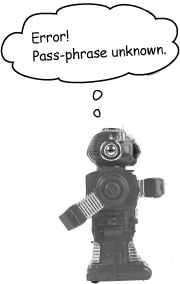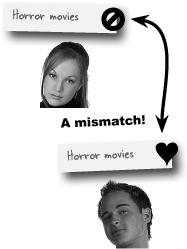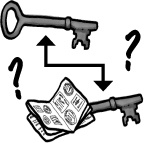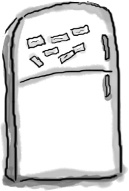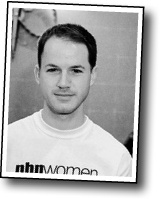If you can answer “yes” to all of these:
Are you a web designer with HTML or XHTML experience and a desire to take your web pages to the next level?
Do you want to go beyond simple HTML pages to learn, understand, and remember how to use PHP and MySQL to build web applications?
Do you prefer stimulating dinner party conversation to dry, dull, academic lectures?
this book is for you.
If you can answer “yes” to any of these:
Are you completely unfamiliar with basic programming concepts like variables and loops?
(But even if you’ve never programmed before, you’ll probably be able to get the key concepts you need from this book.)
Are you a kick-butt PHP web developer looking for a reference book?
Are you afraid to try something different? Would you rather have a root canal than mix stripes with plaid? Do you believe that a technical book can’t be serious if it creates an alien abduction database?
this book is not for you.
“How can this be a serious PHP and MySQL book?”
“What’s with all the graphics?”
“Can I actually learn it this way?”
Your brain craves novelty. It’s always searching, scanning, waiting for something unusual. It was built that way, and it helps you stay alive.
So what does your brain do with all the routine, ordinary, normal things you encounter? Everything it can to stop them from interfering with the brain’s real job—recording things that matter. It doesn’t bother saving the boring things; they never make it past the “this is obviously not important” filter.
How does your brain know what’s important? Suppose you’re out for a day hike and a tiger jumps in front of you, what happens inside your head and body?
Neurons fire. Emotions crank up. Chemicals surge.
And that’s how your brain knows...
This must be important! Don’t forget it!
But imagine you’re at home, or in a library. It’s a safe, warm, tiger-free zone. You’re studying. Getting ready for an exam. Or trying to learn some tough technical topic your boss thinks will take a week, ten days at the most.
Just one problem. Your brain’s trying to do you a big favor. It’s trying to make sure that this obviously non-important content doesn’t clutter up scarce resources. Resources that are better spent storing the really big things. Like tigers. Like the danger of fire. Like how to quickly hide the browser window with the YouTube video of space alien footage when your boss shows up.
And there’s no simple way to tell your brain, “Hey brain, thank you very much, but no matter how dull this book is, and how little I’m registering on the emotional Richter scale right now, I really do want you to keep this stuff around.”
If you really want to learn, and you want to learn more quickly and more deeply, pay attention to how you pay attention. Think about how you think. Learn how you learn.
Most of us did not take courses on metacognition or learning theory when we were growing up. We were expected to learn, but rarely taught to learn.
But we assume that if you’re holding this book, you really want to learn how to build database-driven web sites with PHP and MySQL. And you probably don’t want to spend a lot of time. If you want to use what you read in this book, you need to remember what you read. And for that, you’ve got to understand it. To get the most from this book, or any book or learning experience, take responsibility for your brain. Your brain on this content.
The trick is to get your brain to see the new material you’re learning as Really Important. Crucial to your well-being. As important as a tiger. Otherwise, you’re in for a constant battle, with your brain doing its best to keep the new content from sticking.
So just how DO you get your brain to treat PHP & MySQL like it was a hungry tiger?
There’s the slow, tedious way, or the faster, more effective way. The slow way is about sheer repetition. You obviously know that you are able to learn and remember even the dullest of topics if you keep pounding the same thing into your brain. With enough repetition, your brain says, “This doesn’t feel important to him, but he keeps looking at the same thing over and over and over, so I suppose it must be.”
The faster way is to do anything that increases brain activity, especially different types of brain activity. The things on the previous page are a big part of the solution, and they’re all things that have been proven to help your brain work in your favor. For example, studies show that putting words within the pictures they describe (as opposed to somewhere else in the page, like a caption or in the body text) causes your brain to try to makes sense of how the words and picture relate, and this causes more neurons to fire. More neurons firing = more chances for your brain to get that this is something worth paying attention to, and possibly recording.
A conversational style helps because people tend to pay more attention when they perceive that they’re in a conversation, since they’re expected to follow along and hold up their end. The amazing thing is, your brain doesn’t necessarily care that the “conversation” is between you and a book! On the other hand, if the writing style is formal and dry, your brain perceives it the same way you experience being lectured to while sitting in a roomful of passive attendees. No need to stay awake.
But pictures and conversational style are just the beginning...
We used pictures, because your brain is tuned for visuals, not text. As far as your brain’s concerned, a picture really is worth a thousand words. And when text and pictures work together, we embedded the text in the pictures because your brain works more effectively when the text is within the thing the text refers to, as opposed to in a caption or buried in the text somewhere.
We used redundancy, saying the same thing in different ways and with different media types, and multiple senses, to increase the chance that the content gets coded into more than one area of your brain.
We used concepts and pictures in unexpected ways because your brain is tuned for novelty, and we used pictures and ideas with at least some emotional content, because your brain is tuned to pay attention to the biochemistry of emotions. That which causes you to feel something is more likely to be remembered, even if that feeling is nothing more than a little humor, surprise, or interest.
We used a personalized, conversational style, because your brain is tuned to pay more attention when it believes you’re in a conversation than if it thinks you’re passively listening to a presentation. Your brain does this even when you’re reading.
We included more than 80 activities, because your brain is tuned to learn and remember more when you do things than when you read about things. And we made the exercises challenging-yet-do-able, because that’s what most people prefer.
We used multiple learning styles, because you might prefer step-by-step procedures, while someone else wants to understand the big picture first, and someone else just wants to see an example. But regardless of your own learning preference, everyone benefits from seeing the same content represented in multiple ways.
We include content for both sides of your brain, because the more of your brain you engage, the more likely you are to learn and remember, and the longer you can stay focused. Since working one side of the brain often means giving the other side a chance to rest, you can be more productive at learning for a longer period of time.
And we included stories and exercises that present more than one point of view, because your brain is tuned to learn more deeply when it’s forced to make evaluations and judgments.
We included challenges, with exercises, and by asking questions that don’t always have a straight answer, because your brain is tuned to learn and remember when it has to work at something. Think about it—you can’t get your body in shape just by watching people at the gym. But we did our best to make sure that when you’re working hard, it’s on the right things. That you’re not spending one extra dendrite processing a hard-to-understand example, or parsing difficult, jargon-laden, or overly terse text.
We used people. In stories, examples, pictures, etc., because, well, because you’re a person. And your brain pays more attention to people than it does to things.
So, we did our part. The rest is up to you. These tips are a starting point; listen to your brain and figure out what works for you and what doesn’t. Try new things.
Slow down. The more you understand, the less you have to memorize.
Don’t just read. Stop and think. When the book asks you a question, don’t just skip to the answer. Imagine that someone really is asking the question. The more deeply you force your brain to think, the better chance you have of learning and remembering.
Do the exercises. Write your own notes.
We put them in, but if we did them for you, that would be like having someone else do your workouts for you. And don’t just look at the exercises. Use a pencil. There’s plenty of evidence that physical activity while learning can increase the learning.
Read the “There are No Dumb Questions”
That means all of them. They’re not optional sidebars—they’re part of the core content! Don’t skip them.
Make this the last thing you read before bed. Or at least the last challenging thing.
Part of the learning (especially the transfer to long-term memory) happens after you put the book down. Your brain needs time on its own, to do more processing. If you put in something new during that processing time, some of what you just learned will be lost.
Drink water. Lots of it.
Your brain works best in a nice bath of fluid. Dehydration (which can happen before you ever feel thirsty) decreases cognitive function.
Talk about it. Out loud.
Speaking activates a different part of the brain. If you’re trying to understand something, or increase your chance of remembering it later, say it out loud. Better still, try to explain it out loud to someone else. You’ll learn more quickly, and you might uncover ideas you hadn’t known were there when you were reading about it.
Listen to your brain.
Pay attention to whether your brain is getting overloaded. If you find yourself starting to skim the surface or forget what you just read, it’s time for a break. Once you go past a certain point, you won’t learn faster by trying to shove more in, and you might even hurt the process.
Feel something.
Your brain needs to know that this matters. Get involved with the stories. Make up your own captions for the photos. Groaning over a bad joke is still better than feeling nothing at all.
Write a lot of code!
There’s only one way to learn to program: writing a lot of code. And that’s what you’re going to do throughout this book. Coding is a skill, and the only way to get good at it is to practice. We’re going to give you a lot of practice: every chapter has exercises that pose problems for you to solve. Don’t just skip over them—a lot of the learning happens when you solve the exercises. We included a solution to each exercise—don’t be afraid to peek at the solution if you get stuck! (It’s easy to get snagged on something small.) But try to solve the problem before you look at the solution. And definitely get it working before you move on to the next part of the book.
This is a learning experience, not a reference book. We deliberately stripped out everything that might get in the way of learning whatever it is we’re working on at that point in the book. And the first time through, you need to begin at the beginning, because the book makes assumptions about what you’ve already seen and learned.
We begin by teaching simple programming concepts and database connection basics, then more complicated PHP functions and MySQL statements, and finally more complex application concepts.
While it’s important to create applications that allow users to add data to and retrieve data from your web application, before you can do that you need to understand the syntax of both PHP and MySQL. So we begin by giving you PHP and MySQL statements that you can actually try yourself. That way you can immediately do something with PHP and MySQL, and you will begin to get excited about them. Then, a bit later in the book, we show you good application and database design practices. By then you’ll have a solid grasp of the syntax you need, and can focus on learning the concepts.
We don’t cover every PHP and MySQL statement, function, or keyword.
While we could have put every single PHP and MySQL statement, function, and keyword in this book, we thought you’d prefer to have a reasonably liftable book that would teach you the most important statements, functions, and keywords. We give you the ones you need to know, the ones you’ll use 95 percent of the time. And when you’re done with this book, you’ll have the confidence to go look up that function you need to finish off that kick-ass application you just wrote.
We support PHP 5 and MySQL 5.0.
Note
You can actually use PHP 4 with this book by making a few modifications to the code. Check them out in #1 of Appendix A.
Because so many people still use PHP 4 or 5, we avoid any PHP 4, 5, or 6 specific code wherever possible. We suggest you use PHP 5 or 6 and MySQL 5 or 6 while learning the concepts in this book. In developing this book, we focused on PHP 5 and MySQL 5, while making sure our code was compatible with later versions.
You need a web server that supports PHP.
PHP has to be run through a web server to work correctly. You need Apache or some other web server installed on your local machine or a machine to which you have some access so that you can run MySQL commands on the data. Check out Appendixes ii and iii for instructions on how to install and extend PHP and MySQL.
We use MySQL.
While there’s Standard SQL language, in this book we focus on the particular syntax of MySQL. With only a few syntax changes, the code in this book should work with Oracle, MS SQL Server, PostgreSQL, DB2, and quite a few more Relational Database Management Systems (RDBMSs) out there. You’ll need to look up the particular PHP functions and syntax if you want to connect to these other RDBMSs. If we covered every variation in syntax for every command in the book, this book would have many more pages. We like trees, so we’re focusing on MySQL.
The activities are NOT optional.
The exercises and activities are not add-ons; they’re part of the core content of the book. Some of them are to help with memory, some are for understanding, and some will help you apply what you’ve learned. Don’t skip the exercises. The crossword puzzles are the only thing you don’t have to do, but they’re good for giving your brain a chance to think about the words and terms you’ve been learning in a different context.
The redundancy is intentional and important.
One distinct difference in a Head First book is that we want you to really get it. And we want you to finish the book remembering what you’ve learned. Most reference books don’t have retention and recall as a goal, but this book is about learning, so you’ll see some of the same concepts come up more than once.
The examples are as lean as possible.
Our readers tell us that it’s frustrating to wade through 200 lines of an example looking for the two lines they need to understand. Most examples in this book are shown within the smallest possible context, so that the part you’re trying to learn is clear and simple. Don’t expect all of the examples to be ultra robust, or always complete—they are written specifically for learning, and aren’t necessarily fully-functional.
We’ve placed all of the example code and applications on the Web so you can copy and paste parts of them into your text editor or MySQL Terminal, or upload them as-is to your own web server for testing. You’ll find it all at http://www.headfirstlabs.com/books/hfphp/
The Brain Power exercises don’t have answers.
For some of them, there is no right answer, and for others, part of the learning experience of the Brain Power activities is for you to decide if and when your answers are right. In some of the Brain Power exercises, you will find hints to point you in the right direction.
Technical Reviewers:
Jereme Allen is a senior level web developer with experience utilizing state of the art technologies to create web applications. He has nine plus years of experience utilizing PHP, MySQL, as well as various other frameworks, operating systems, programming languages and development software.
David Briggs is a technical author and software localization engineer living in Birmingham, England. When he’s not being finicky about how to guide users through a particularly tricky piece of software, he likes nothing better than to get out in the local park with his wife, Paulette, and Cleo, the family dog.
Will Harris spends his days running an IT department that provides services to 11 companies on 4 continents, and he is the Vice President of the Las Vegas PASS (Professional Association for SQL Server) chapter. At night, he hops into a phone booth and puts on his web 2.0 suit, helping the designers and developers at Powered By Geek ensure that their data platforms are flexible, portable, maintainable, and FAST, using MySQL and Rails. He also enjoys spending time with his wife, Heather, his beautiful children, Mara and Ellie, and his dog, Swiper.
Stephanie Liese is a technical trainer and web developer in Sacramento, California. When she isn’t extolling the virtues of standards compliant code or debugging a CSS layout, you will find her sweating it out in a hot yoga class.
If Steve Milano isn’t slinging code for The Day Job™ or playing punk rock with his band, Onion Flavored Rings, in some unventilated basement, he’s probably at home with his laptop, neglecting feline companion, Ralph, and human companion, Bianca.
Harvey Quamen gave up a computer programming career to join the jet-setting, paparazzi-filled, high profile world of academia. He’s currently an Associate Professor of English and Humanities Computing at the University of Alberta, where he teaches courses on cyberculture, 20th-century literature, and web development—including PHP and MySQL.
Chris Shiflett is the Chief Technology Officer of OmniTI, where he leads the web application security practice and guides web development initiatives. Chris is a thought leader in the PHP and web application security communities—a widely-read blogger at shiflett.org, a popular speaker at industry conferences worldwide, and the founder of the PHP Security Consortium. His books include Essential PHP Security (O’Reilly) and HTTP Developer’s Handbook (Sams).
Our editors:
Many thanks go to Brett McLaughlin for the awesome storyboarding session that got us on the right track, and his ruthless commitment to cognitive learning.
The book would not exist if not for the heroic effort, patience, and persistence of Sanders Kleinfeld. He always managed to catch the balls, or was it cats, we were juggling when we inevitably dropped one (or three!), and we appreciate it. We hope he gets a chance to put his feet up for a couple of days before taking on another project as difficult as this one.
The O’Reilly team:
Thanks to Lou Barr for her phenomenal design skill, making this book such a visual treat.
Thanks also to Brittany Smith for all her hard work at the last minute, and to Caitrin McCullough for getting the example web sites up and running. And to Laurie Petrycki for having faith that we could write another great Head First book.
And more:
Finally, a big thanks goes out to Elvis Wilson for putting together the alien YouTube videos for Chapter 13. Excellent job! Especially seeing as how he’s merely a simple caveman art director.
![]() When you see a Safari® icon on the cover of your favorite technology book that means the book is available online through the O’Reilly Network Safari Bookshelf.
When you see a Safari® icon on the cover of your favorite technology book that means the book is available online through the O’Reilly Network Safari Bookshelf.
Safari offers a solution that’s better than e-books. It’s a virtual library that lets you easily search thousands of top tech books, cut and paste code samples, download chapters, and find quick answers when you need the most accurate, current information. Try it for free at http://safari.oreilly.com.
Get Head First PHP & MySQL now with the O’Reilly learning platform.
O’Reilly members experience books, live events, courses curated by job role, and more from O’Reilly and nearly 200 top publishers.






